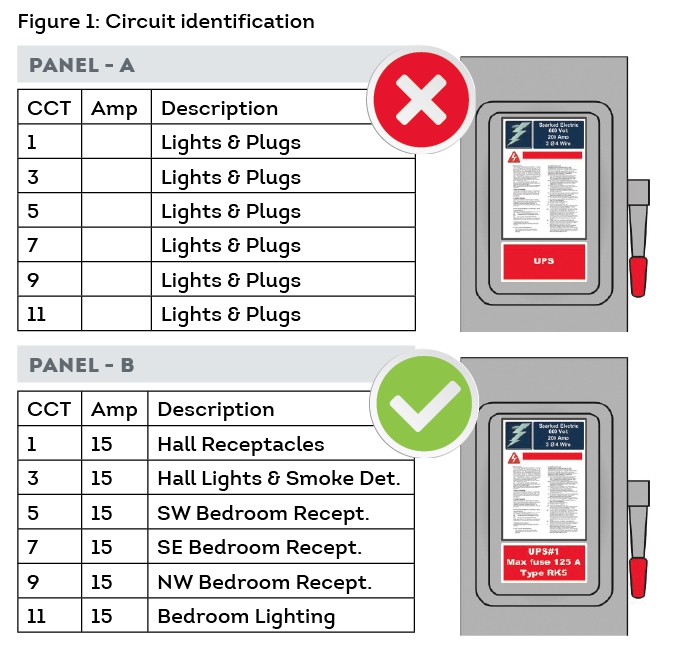
Features
Code File
Codes & Standards
CE Code Rule 2-100 “Marking of equipment“ • Nansy Hanna
July 7, 2016 | By Nansy Hanna
 Figure 1
Figure 1 July 7, 2016 – Equipment marking contributes to the safety of electrical installations by identifying switches and breakers so that circuits can be de-energized, allowing for the timely and accurate identification of circuits so that loads are not inadvertently de-energized; and providing workers with the means to de-energize circuits more conveniently, reducing the likelihood that a worker will engage in unsafe work practices.
And yet, over the past year, our inspectors identified more than 4000 defects related to the marking of electrical equipment.
All circuits in electrical installations should be described accurately with as few words as practical. For example, it is not acceptable to only mark circuits as “lights” and “plugs”. The room number(s) where the circuit is present should be provided, for example; or, for residential installations, a description of the area to which the circuit supplies, such as basement, living/dining room or bedroom (Figure 1). Particular circuits need to be properly identified, such as stove, washer, dryer, microwave, dishwasher, outside receptacle.
The CE Code requires distribution points, circuit breakers, fuses and switches to be marked in a conspicuous location and in a legible manner to indicate which portion of the installation they protect or control. Additionally, where specific fuse types are required (e.g. Type P, Type D, HRC Form 1), the fuse type shall be shown with the permitted maximum fuse rating.
A key requirement contained in Rule 2-100 for marking electrical equipment addresses concerns regarding the safe use and operation of installations by requiring “other markings necessary to ensure safe and proper operation” as indicated in Subrule (m).
This Subrule, however, is rarely applied because of its vagueness, so let’s consider an application of this Subrule with other markings that can increase safety. A good example relates to new Rule 4-004(23), where service conductors for a single dwelling are permitted to be reduced based on the calculated load. In a 100A single-dwelling service, for instance, #4 AWG copper conductor is permitted to be installed as a service conductor based on an 89A calculated load.
Were the panel marked with a warning “Caution! 89A Maximum Load”, would it increase safety? Yes, because it would alert the consumer to consider the loading capabilities of the service before adding considerable loads, such as hot tubs or electric vehicle charging stations.
Generally, the requirements contained within Rule 2-100 “Marking of equipment” help support compliance with other CE Code requirements with regard to the proper use and maintenance of an electrical installation, as they provide individuals with valuable information regarding the characteristics of an installation.
Nansy Hanna is the director for Engineering & Program Development at Electrical Safety Authority (ESA) where, among other things, she is responsible for product safety, code development, improving harmonization and alternative compliance, worker safety, and aging infrastructure programs. She is a LEED-Accredited Professional and a member of CSA CE Code-Part I, Sections 24, 32, 46, 50 and 64. Nansy can be reached at nansy.hanna@electricalsafety.on.ca .
N.B. Always consult your AHJ for more specific interpretations.
* This article also appears in the July 2016 edition of Electrical Business Magazine. Check out our ARCHIVE page for back issues.
Print this page